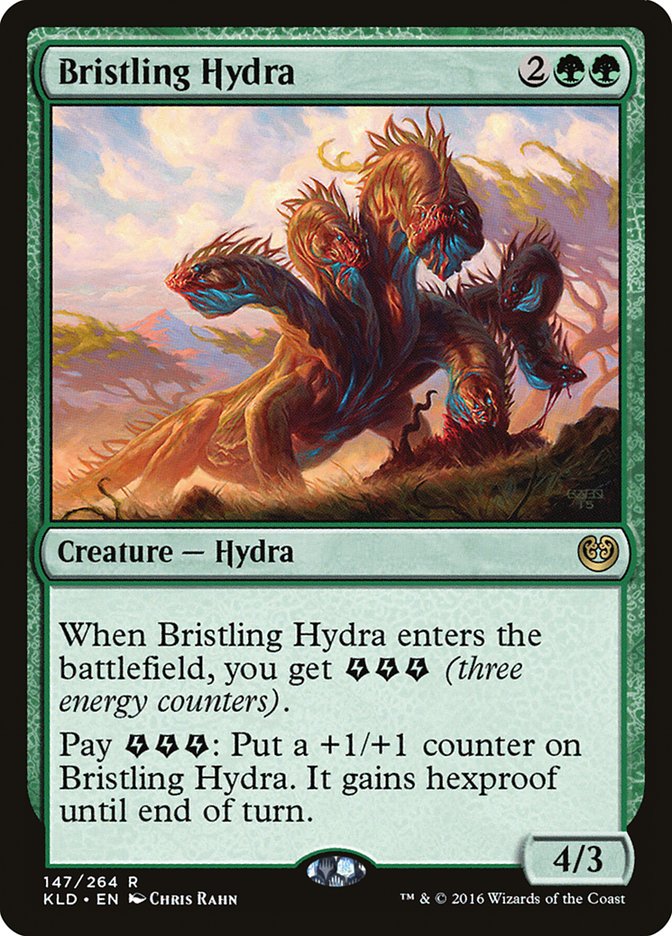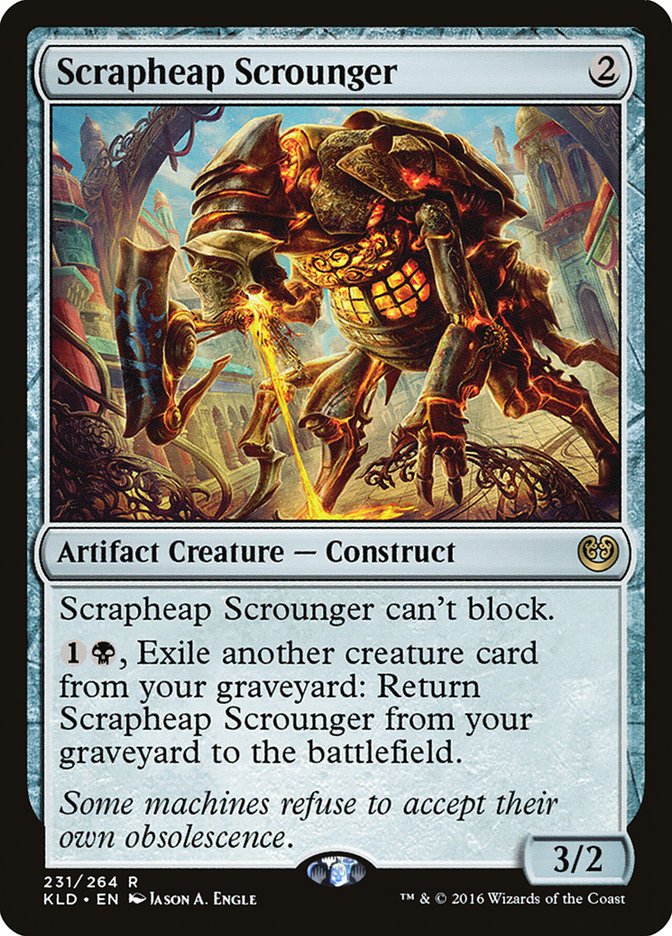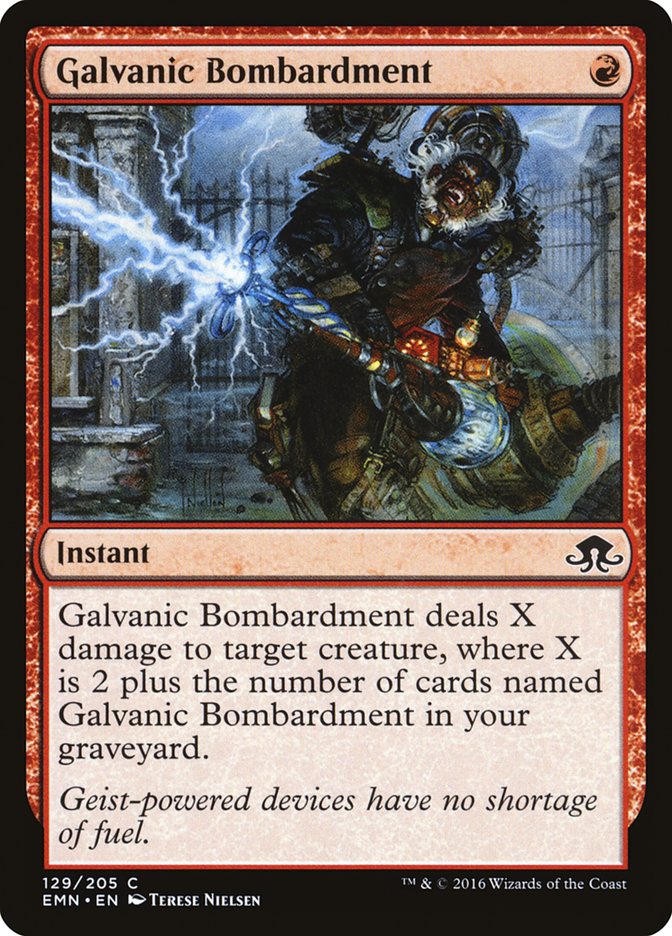Pro Tour Kaladesh is behind us and it appears that, for the time being, control is king. Shota Yasooka is our new champion with a Grixis Control build featuring Torrential Gearhulk and Thing in the Ice as primary win conditions. I am left wondering if this deck is going to be a major player in the new Standard format or if this deck, like many before, is a deck only Shota will find success with.
Creatures (6)
Planeswalkers (1)
Lands (26)
Spells (27)

Preparing for this tournament was much more difficult than any Standard tournament I’ve ever prepared for. Testing Kaladesh Standard felt a lot like Modern to me. Fast aggressive decks with good mana. Combo decks that put Emrakul, the Promised End onto the battlefield on turn 4. Vehicles and Scrapheap Scrounger gave aggressive decks a rare resiliency, making it difficult to keep up with aggressive decks for a control player. R/G Energy Aggro felt a lot like Modern Infect, having the ability to kill on turn 4 through removal with a Larger Than Life Bristling Hydra.
With so many powerful cards and strategies in the format, it was extremely difficult to pinpoint a metagame. The early indication was that R/W Vehicles was the deck to beat, and with good reason. I was thoroughly impressed at how well-built the deck Chris VanMeter piloted to victory at the SCG Tour stop in Indianapolis was. Days of testing went by trying to find a few decks that could compete with R/W Vehicles, and very few did.
After playing countless hours with a wide variety of ideas, we settled on a Jund Delirium deck that featured Grim Flayer and Kalitas, Traitor of Ghet, unlike previous iterations, though this Jund Delirum deck was much closer to traditional B/G Delirium with just a pair of Radiant Flames to replace Languish from last season than it was to previous iterations with Kozilek’s Return. Our initial idea was that various Prized Amalgam decks and aggressive strategies like R/W Vehicles and R/B Aggro would dominate the metagame. For this purpose, we thought we could play a reactive strategy focused on beating these decks and go over the top of any control decks that wanted to try to step in their way with Emrakul, the Promised End.
This was my decklist at Pro Tour Kaladesh:
Creatures (14)
- 2 Pilgrim's Eye
- 3 Kalitas, Traitor of Ghet
- 1 Emrakul, the Promised End
- 1 Distended Mindbender
- 3 Ishkanah, Grafwidow
- 4 Grim Flayer
Planeswalkers (4)
Lands (17)
Spells (25)

In the end, we were wrong.
You see, in testing, we always play as if we know what’s going on within a matchup. We know each other’s decks, and know each other’s sideboard plans. We do this because it’s important to try to win the tournament, and in the Top 8 you get each other’s decklist to test the matchup the night before.
Unfortunately, in the Swiss rounds, you do not have this luxury, especially with newer scouting rules at the Pro Tour where you do not see your opponent’s name before your match. So what ends up happening in testing is you keep hands that are good in your matchup, while in the tournament you don’t know if your removal-heavy draw is great or if you kept a hand full of dead cards. This leads to a lot of awkward decisions, and with a metagame as wide open as Pro Tour Kaladesh ended up, it was close to a disaster. The team ended up with approximately a 55% win percentage, while my personal record was 3-7 with the deck. I was paired against our nightmare matchups six times and against closer matchups in the other rounds. That was another of the major problems with the deck: even when it’s favored, it was favored by maybe 10-15%, while its bad matchups were much worse than a 10-15% underdog.
We knew planeswalkers would be at a low in maindecks because of how well Vehicles, especially Smuggler’s Copter, lined up against them. This led us to move planeswalker removal spells into our sideboard. Ruinous Path and To the Slaughter are excellent at dealing with planeswalkers but pretty poorly positioned otherwise. The last thing I want to do is cast a three-mana spell that only removes a Thopter token left behind by Pia Nalaar. In testing, we knew when planeswalkers were coming in, so we were a step ahead and knew to bring in our Ruinous Paths or To the Slaughters. However, at the Pro Tour, we didn’t know if our opponents would have Chandra, Torch of Defiance or Gideon, Ally of Zendikar. This led to an awkward guessing game of sideboard decisions that would either leave you cold to a planeswalker or stranded with a mediocre spell in your hand. I played against multiple U/R Zombies decks that sideboarded in both Fevered Visions and Chandra, Torch of Defiance; I was caught off-guard the first match and simply lost to Fevered Visions Game 2.
We considered the possibilities of the issues the deck had, so we didn’t miss them entirely, but I don’t think we put enough weight on the problems of the deck when making our decision to play this Jund Delirium deck. Ultimately I feel it was a mistake to play this deck at the Pro Tour.
Planeswalkers and awkward keep-or-mulligan decisions weren’t the only reason I thought this deck ended up being a mistake to play at the Pro Tour. Another reason was that the wide-open metagame left too many bases to cover.
As days passed, more and more decks popped up in the Magic Online metagame. One of the more problematic decks that popped up was R/G Energy Aggro featuring Bristling Hydra and a combo kill with Larger Than Life and Uncaged Fury. Bristling Hydra was nearly impossible to beat. Our deck featured spot removal and Radiant Flames as our only sweeper effect, and Bristling Hydra easily protected itself from both. After testing R/G Energy Aggro, we decided it was mediocre against aggressive decks and not quite consistent enough to be an option, so we thought it might only make up a small portion of the metagame. That said, it was a new flashy deck with explosive draws revolving around Energy, a new mechanic, and people are generally drawn to play these flashy decks early in a format.
Aetherworks Marvel was by far our worst matchup. Our initial testing indicated that Aetherworks Marvel was too weak to hate as well as too inconsistent to be a major player in the metagame. Apparently, we were wrong. Other large teams decided it was good enough to roll the dice with, and it ended up being the most highly represented deck in the tournament. I don’t have the exact statistics on Aetherworks Marvel win percentages, but it appears we may have been right on how well we thought the deck would perform after talking to other major teams who played versions of the deck to mediocre results. In other words, we were likely right the deck was weak; we were just wrong about how many people ended up playing it.
Both of these decks revolving around Energy were bad matchups for our Jund Delirium deck, and we should have done a better job considering this before choosing to play Jund Delirium at the Pro Tour.
Overall we did quite poorly with the deck, with only one player cashing the event out of ten pilots.
Now for the Good News…
All of that is the bad news. The good news is I think the deck might have a home in Standard moving forward. With control decks dominating the Pro Tour, I think B/G Delirium has a home in Standard.
The blue control decks have great matchups against Aetherworks Marvel to suppress your worst matchup, and both the extremes of aggro and control are good for the B/G Delirium deck. Notice I said B/G Delirium instead of Jund. I think removing the Radiant Flames from the deck is a good choice moving forward, as it’s not good against control and not entirely necessary against aggro. This will lead to a much smoother manabase and you won’t have to shake your head every time you see a Mountain in your opening hand, like I did what felt like a thousand times at the Pro Tour. You can simply replace Radiant Flames with more removal, potentially Ruinous Path or To the Slaughter, as I’d expect an uptick in planeswalkers with control decks being the big winner at Pro Tour Kaladesh.
If I were to play a B/G Delirium deck this weekend, it would look something like this:
Creatures (14)
- 2 Pilgrim's Eye
- 2 Kalitas, Traitor of Ghet
- 1 Tireless Tracker
- 1 Emrakul, the Promised End
- 1 Distended Mindbender
- 3 Ishkanah, Grafwidow
- 4 Grim Flayer
Planeswalkers (4)
Lands (18)
Spells (24)

I don’t quite know how people will react to the Pro Tour, but if control ends up being extremely popular in the wake of its recent success, it’s possible you don’t want to add Ruinous Path to replace Radiant Flames but maybe an additional Tireless Tracker instead of one. I could see wanting a pair of Flaying Tendrils out of the sideboard as well, with decks like Makis Matsoukas’s R/W Tokens deck making a splash at Pro Tour Kaladesh. Arborback Stomper may be a bit dated, but it was a way to find lifegain with Traverse the Ulvenwald against R/B Aggro, a deck that had a tendency to burn you out in very close games. If R/B Aggro falls out of favor, cut it for some more interaction.
B/G Delirium is the kind of deck that performs much better in a defined metagame. As the metagame matures, we will know more of what we want to do to shape the deck to its perfect form, but until we have a solid idea of what people will play moving forward, it may be a deck that we have to wait and see on. I think the deck will line up well against both Grixis Control and Jeskai Control and has close but favorable matchups against both R/W Vehicles and R/B Aggro. If people are still drawn to Aetherworks Marvel combo, I would avoid playing B/G Delirium until it’s potentially pushed out of the metagame, as the matchup is incredibly hard and most of the wins against the deck are mostly due to the fail rate of Aetherworks Marvel deck, not anything you are doing from your side of the matchup.
If I could do it over, what would I play?
Well, I was very close to choosing to play R/B Aggro at the Pro Tour. In testing we felt it had no truly bad matchups amongst the decks we had, but it was remarkably close against the other aggressive decks, which we thought would represent a large part of the metagame. The maindeck we had was rather stock, but I really liked our sideboard plan of becoming more controlling against aggro decks and going bigger against midrange decks post-sideboard.
Here’s the deck I wish I played at the Pro Tour, and would consider playing it moving forward if it tests well against control decks:
Creatures (17)
Lands (13)
Spells (30)

Only one person played a deck other than Jund Delirium on Team F2F and that was Steve Rubin. This is the deck he played to a 6-4 record, losing a couple of close matchups down the stretch while still in Top 8 contention.
Sideboarding in the package of Galvanic Bombardment and Kalitas, Traitor of Ghet against aggressive decks like the mirror and R/W Vehicles proved to be an extremely effective strategy. Cards like Key to the City and Fleetwheel Cruiser are generally lackluster in these matchups, so going for a more controlling strategy and closing out the game with Kalitas, Traitor of Ghet is much more effective than a flat-out race.
Chandra, Torch of Defiance heavily improves the matchups against control decks, and in testing, most of the games we’d lose to R/B Aggro with our Jund Delirium decks were to an unchecked Chandra, Torch of Defiance. If it wasn’t Chandra that did us in, it was a Goblin Dark-Dwellers flashing back an Unlicensed Disintegration. Games after sideboarding tend to be longer and grindier than pre-sideboard games, so bringing in the more expensive spells and an additional land allows you to potentially grind out the control decks or simply burn them out.
Even though I had a poor result, Kaladesh Standard is extremely interesting and I believe still wide open. No decks appear to me to be “the best deck in the format” yet, and I really enjoy when there’s still room for improvement and I’m interested to see which direction the format heads. I’d be interested in hearing what you all think the best deck in Standard is moving forward.









